sensor CHRYSLER 300 M 2004 1.G Owners Manual
[x] Cancel search | Manufacturer: CHRYSLER, Model Year: 2004, Model line: 300 M, Model: CHRYSLER 300 M 2004 1.GPages: 277, PDF Size: 5.69 MB
Page 36 of 277
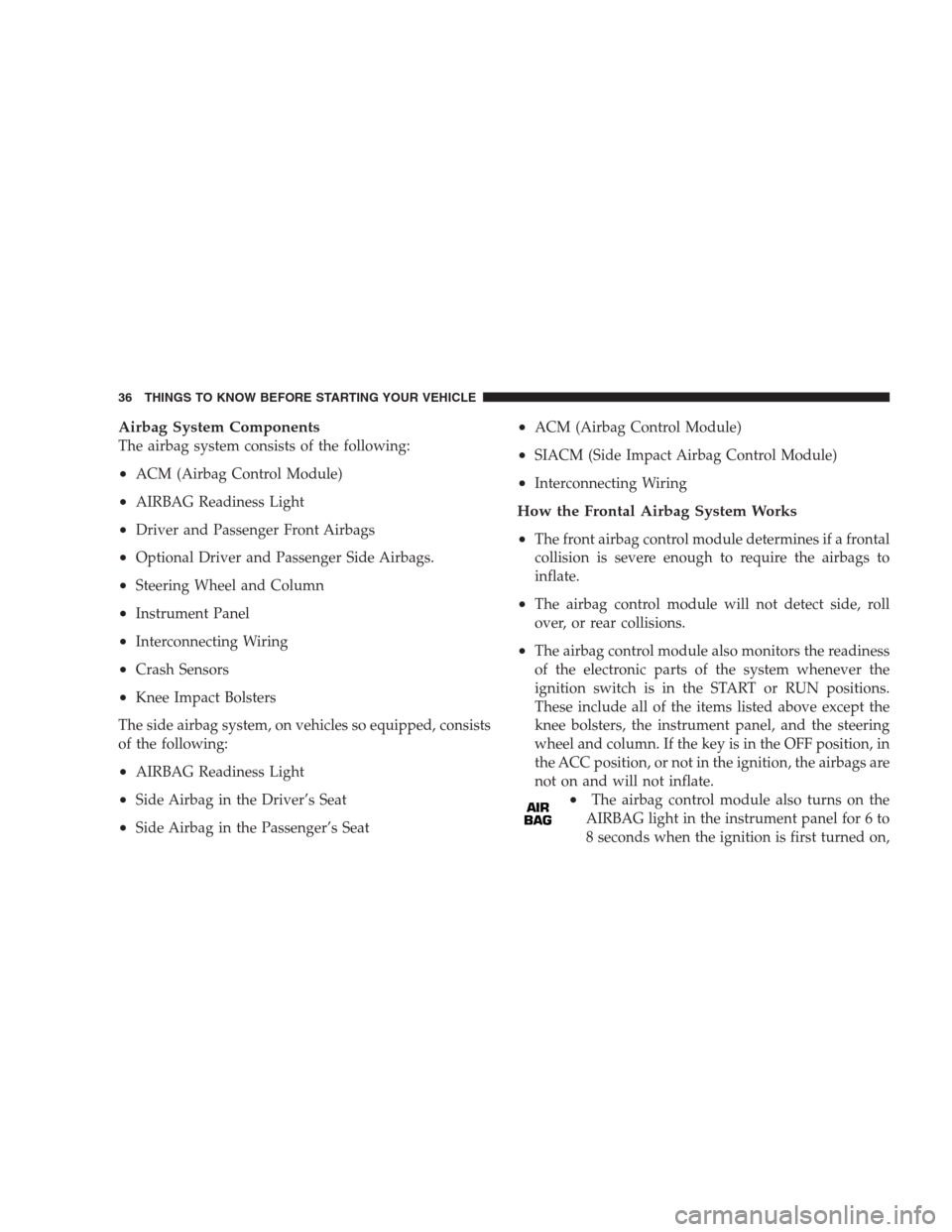
Airbag System Components
The airbag system consists of the following:
•ACM (Airbag Control Module)
•AIRBAG Readiness Light
•Driver and Passenger Front Airbags
•Optional Driver and Passenger Side Airbags.
•Steering Wheel and Column
•Instrument Panel
•Interconnecting Wiring
•Crash Sensors
•Knee Impact Bolsters
The side airbag system, on vehicles so equipped, consists
of the following:
•AIRBAG Readiness Light
•Side Airbag in the Driver’s Seat
•Side Airbag in the Passenger’s Seat
•ACM (Airbag Control Module)
•SIACM (Side Impact Airbag Control Module)
•Interconnecting Wiring
How the Frontal Airbag System Works
•
The front airbag control module determines if a frontal
collision is severe enough to require the airbags to
inflate.
•The airbag control module will not detect side, roll
over, or rear collisions.
•The airbag control module also monitors the readiness
of the electronic parts of the system whenever the
ignition switch is in the START or RUN positions.
These include all of the items listed above except the
knee bolsters, the instrument panel, and the steering
wheel and column. If the key is in the OFF position, in
the ACC position, or not in the ignition, the airbags are
not on and will not inflate.
•The airbag control module also turns on the
AIRBAG light in the instrument panel for 6 to
8 seconds when the ignition is first turned on,
36 THINGS TO KNOW BEFORE STARTING YOUR VEHICLE
Page 88 of 277
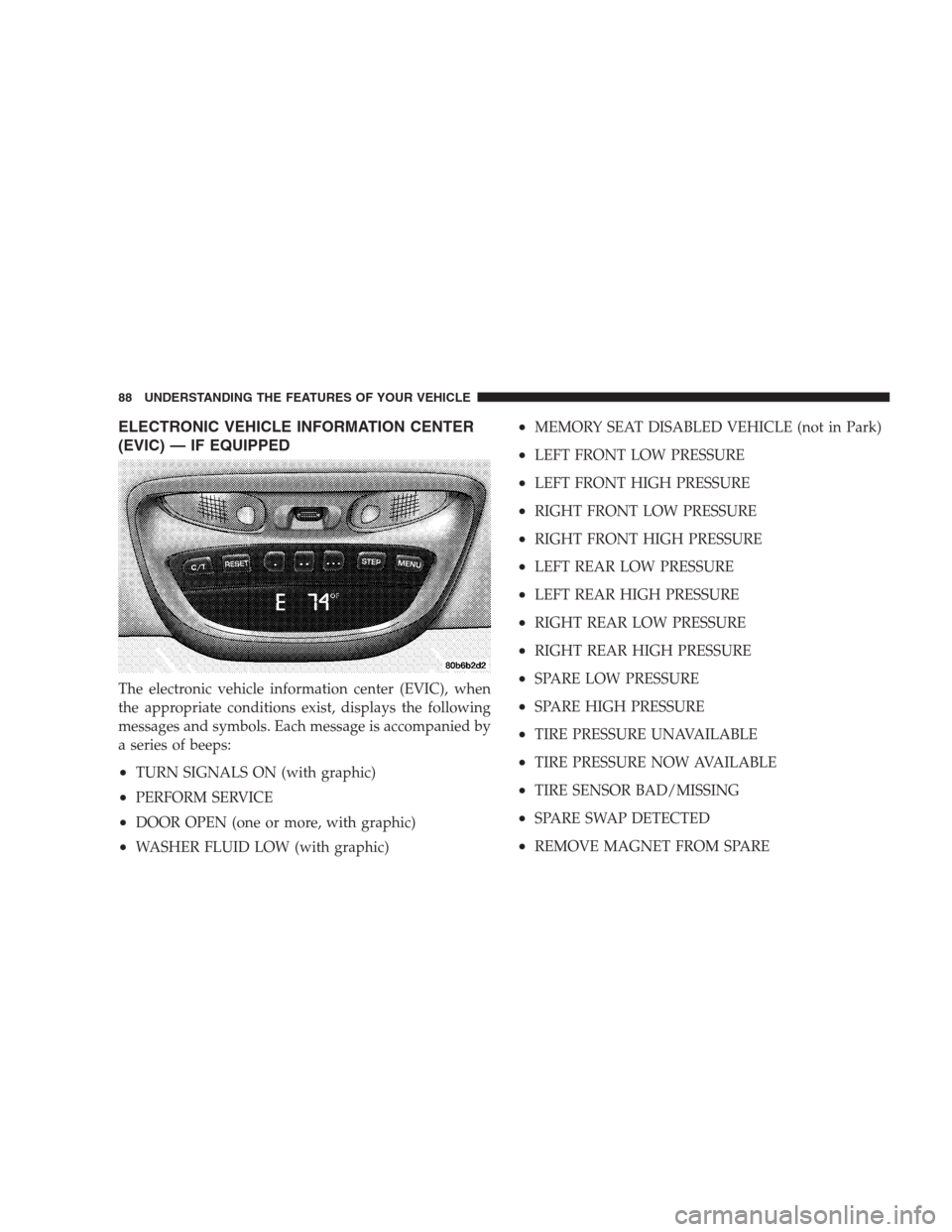
ELECTRONIC VEHICLE INFORMATION CENTER
(EVIC) — IF EQUIPPED
The electronic vehicle information center (EVIC), when
the appropriate conditions exist, displays the following
messages and symbols. Each message is accompanied by
a series of beeps:
•TURN SIGNALS ON (with graphic)
•PERFORM SERVICE
•DOOR OPEN (one or more, with graphic)
•WASHER FLUID LOW (with graphic)
•MEMORY SEAT DISABLED VEHICLE (not in Park)
•LEFT FRONT LOW PRESSURE
•LEFT FRONT HIGH PRESSURE
•RIGHT FRONT LOW PRESSURE
•RIGHT FRONT HIGH PRESSURE
•LEFT REAR LOW PRESSURE
•LEFT REAR HIGH PRESSURE
•RIGHT REAR LOW PRESSURE
•RIGHT REAR HIGH PRESSURE
•SPARE LOW PRESSURE
•SPARE HIGH PRESSURE
•TIRE PRESSURE UNAVAILABLE
•TIRE PRESSURE NOW AVAILABLE
•TIRE SENSOR BAD/MISSING
•SPARE SWAP DETECTED
•REMOVE MAGNET FROM SPARE
88 UNDERSTANDING THE FEATURES OF YOUR VEHICLE
Page 89 of 277
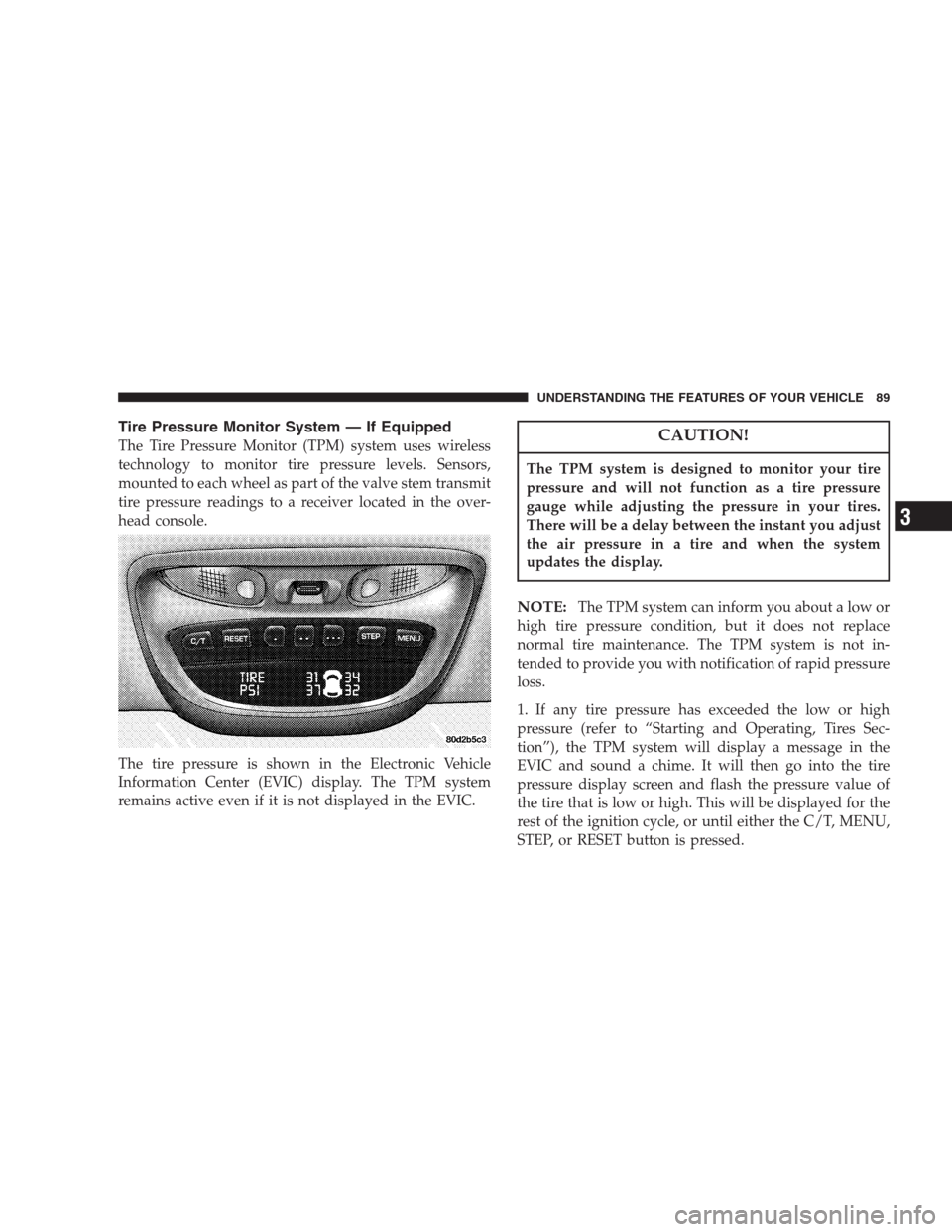
Tire Pressure Monitor System — If Equipped
The Tire Pressure Monitor (TPM) system uses wireless
technology to monitor tire pressure levels. Sensors,
mounted to each wheel as part of the valve stem transmit
tire pressure readings to a receiver located in the over-
head console.
The tire pressure is shown in the Electronic Vehicle
Information Center (EVIC) display. The TPM system
remains active even if it is not displayed in the EVIC.CAUTION!
The TPM system is designed to monitor your tire
pressure and will not function as a tire pressure
gauge while adjusting the pressure in your tires.
There will be a delay between the instant you adjust
the air pressure in a tire and when the system
updates the display.
NOTE:The TPM system can inform you about a low or
high tire pressure condition, but it does not replace
normal tire maintenance. The TPM system is not in-
tended to provide you with notification of rapid pressure
loss.
1. If any tire pressure has exceeded the low or high
pressure (refer to “Starting and Operating, Tires Sec-
tion”), the TPM system will display a message in the
EVIC and sound a chime. It will then go into the tire
pressure display screen and flash the pressure value of
the tire that is low or high. This will be displayed for the
rest of the ignition cycle, or until either the C/T, MENU,
STEP, or RESET button is pressed.
UNDERSTANDING THE FEATURES OF YOUR VEHICLE 89
3
Page 90 of 277
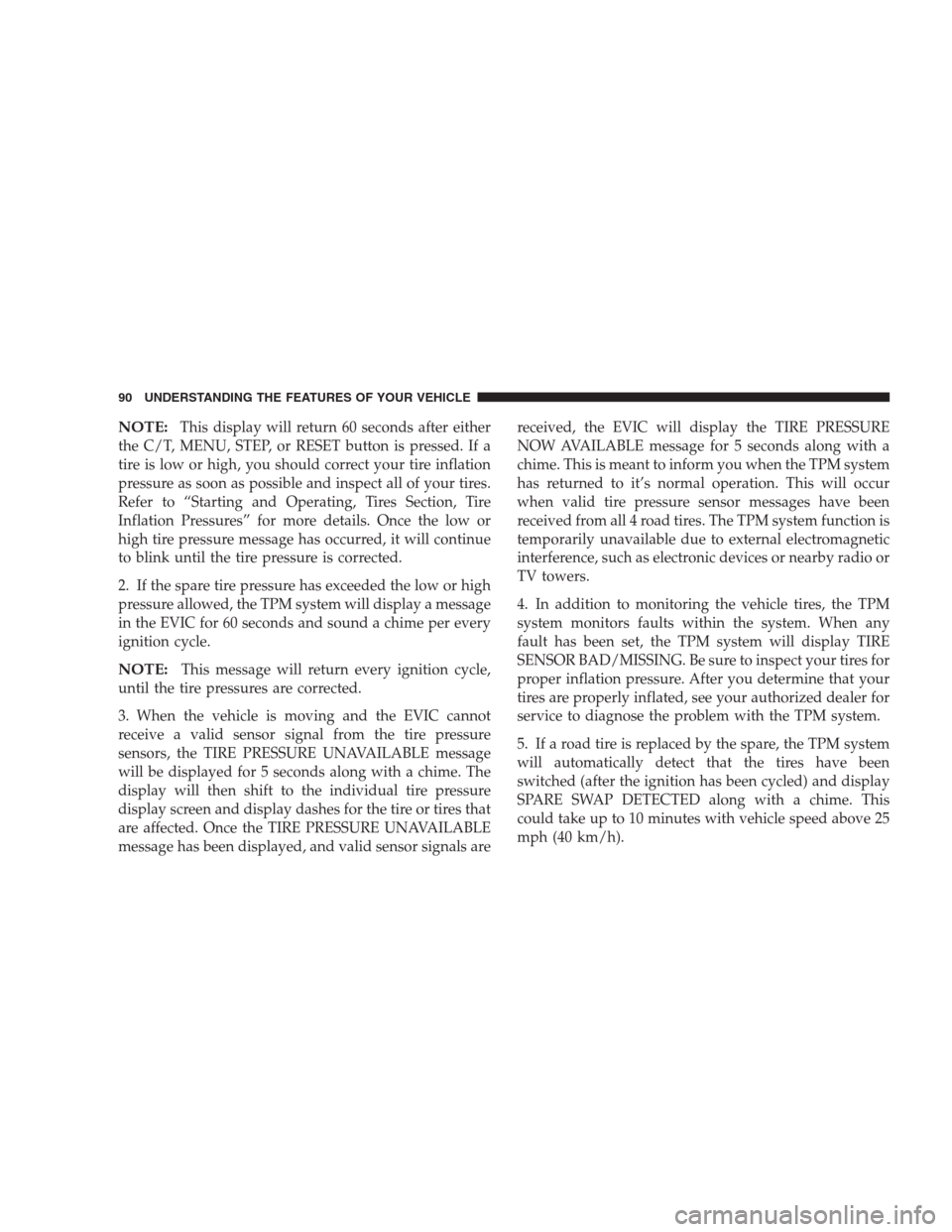
NOTE:This display will return 60 seconds after either
the C/T, MENU, STEP, or RESET button is pressed. If a
tire is low or high, you should correct your tire inflation
pressure as soon as possible and inspect all of your tires.
Refer to “Starting and Operating, Tires Section, Tire
Inflation Pressures” for more details. Once the low or
high tire pressure message has occurred, it will continue
to blink until the tire pressure is corrected.
2. If the spare tire pressure has exceeded the low or high
pressure allowed, the TPM system will display a message
in the EVIC for 60 seconds and sound a chime per every
ignition cycle.
NOTE:This message will return every ignition cycle,
until the tire pressures are corrected.
3. When the vehicle is moving and the EVIC cannot
receive a valid sensor signal from the tire pressure
sensors, the TIRE PRESSURE UNAVAILABLE message
will be displayed for 5 seconds along with a chime. The
display will then shift to the individual tire pressure
display screen and display dashes for the tire or tires that
are affected. Once the TIRE PRESSURE UNAVAILABLE
message has been displayed, and valid sensor signals arereceived, the EVIC will display the TIRE PRESSURE
NOW AVAILABLE message for 5 seconds along with a
chime. This is meant to inform you when the TPM system
has returned to it’s normal operation. This will occur
when valid tire pressure sensor messages have been
received from all 4 road tires. The TPM system function is
temporarily unavailable due to external electromagnetic
interference, such as electronic devices or nearby radio or
TV towers.
4. In addition to monitoring the vehicle tires, the TPM
system monitors faults within the system. When any
fault has been set, the TPM system will display TIRE
SENSOR BAD/MISSING. Be sure to inspect your tires for
proper inflation pressure. After you determine that your
tires are properly inflated, see your authorized dealer for
service to diagnose the problem with the TPM system.
5. If a road tire is replaced by the spare, the TPM system
will automatically detect that the tires have been
switched (after the ignition has been cycled) and display
SPARE SWAP DETECTED along with a chime. This
could take up to 10 minutes with vehicle speed above 25
mph (40 km/h).
90 UNDERSTANDING THE FEATURES OF YOUR VEHICLE
Page 95 of 277
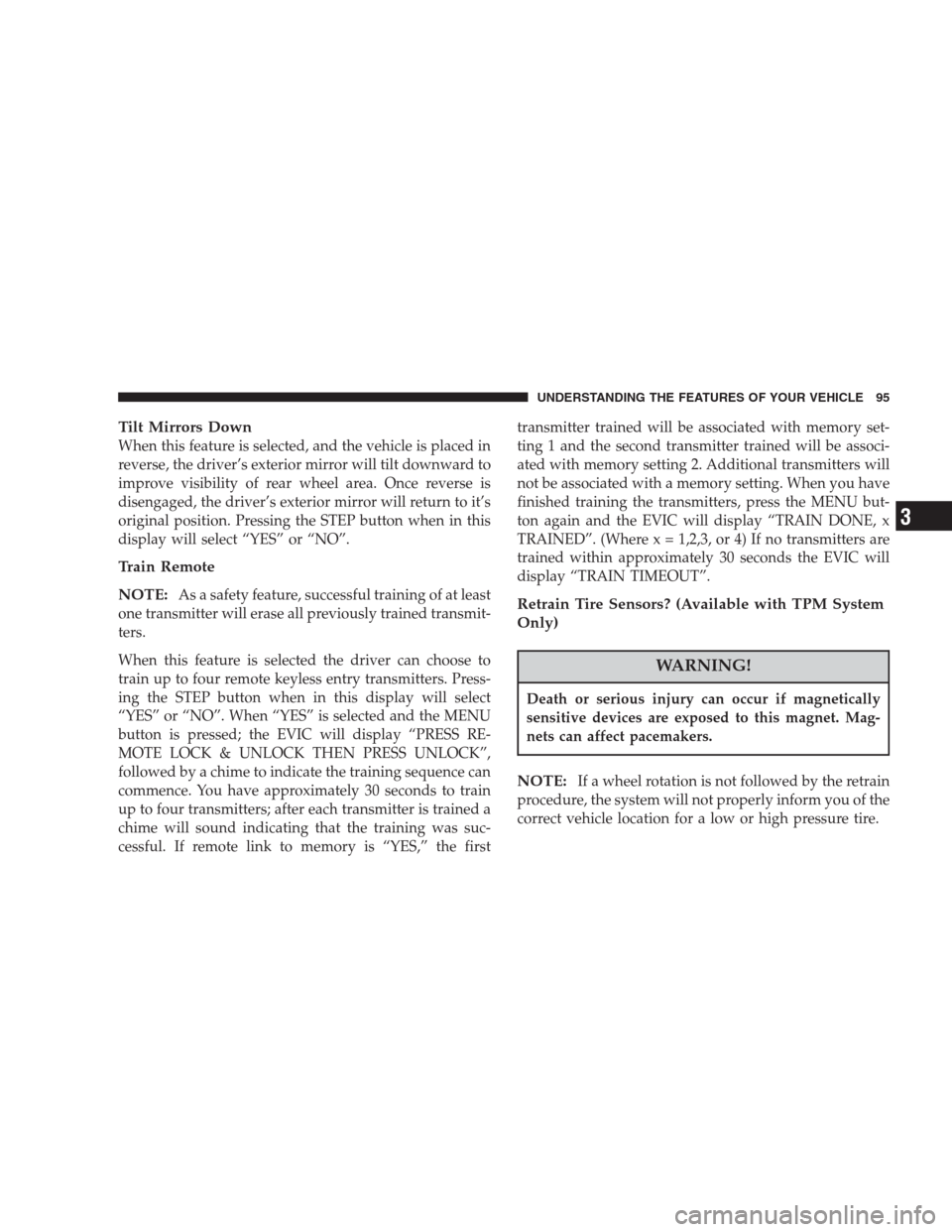
Tilt Mirrors Down
When this feature is selected, and the vehicle is placed in
reverse, the driver’s exterior mirror will tilt downward to
improve visibility of rear wheel area. Once reverse is
disengaged, the driver’s exterior mirror will return to it’s
original position. Pressing the STEP button when in this
display will select “YES” or “NO”.
Train Remote
NOTE:
As a safety feature, successful training of at least
one transmitter will erase all previously trained transmit-
ters.
When this feature is selected the driver can choose to
train up to four remote keyless entry transmitters. Press-
ing the STEP button when in this display will select
“YES” or “NO”. When “YES” is selected and the MENU
button is pressed; the EVIC will display “PRESS RE-
MOTE LOCK & UNLOCK THEN PRESS UNLOCK”,
followed by a chime to indicate the training sequence can
commence. You have approximately 30 seconds to train
up to four transmitters; after each transmitter is trained a
chime will sound indicating that the training was suc-
cessful. If remote link to memory is “YES,” the firsttransmitter trained will be associated with memory set-
ting 1 and the second transmitter trained will be associ-
ated with memory setting 2. Additional transmitters will
not be associated with a memory setting. When you have
finished training the transmitters, press the MENU but-
ton again and the EVIC will display “TRAIN DONE, x
TRAINED”. (Where x = 1,2,3, or 4) If no transmitters are
trained within approximately 30 seconds the EVIC will
display “TRAIN TIMEOUT”.Retrain Tire Sensors? (Available with TPM System
Only)
WARNING!
Death or serious injury can occur if magnetically
sensitive devices are exposed to this magnet. Mag-
nets can affect pacemakers.
NOTE:If a wheel rotation is not followed by the retrain
procedure, the system will not properly inform you of the
correct vehicle location for a low or high pressure tire.
UNDERSTANDING THE FEATURES OF YOUR VEHICLE 95
3
Page 96 of 277
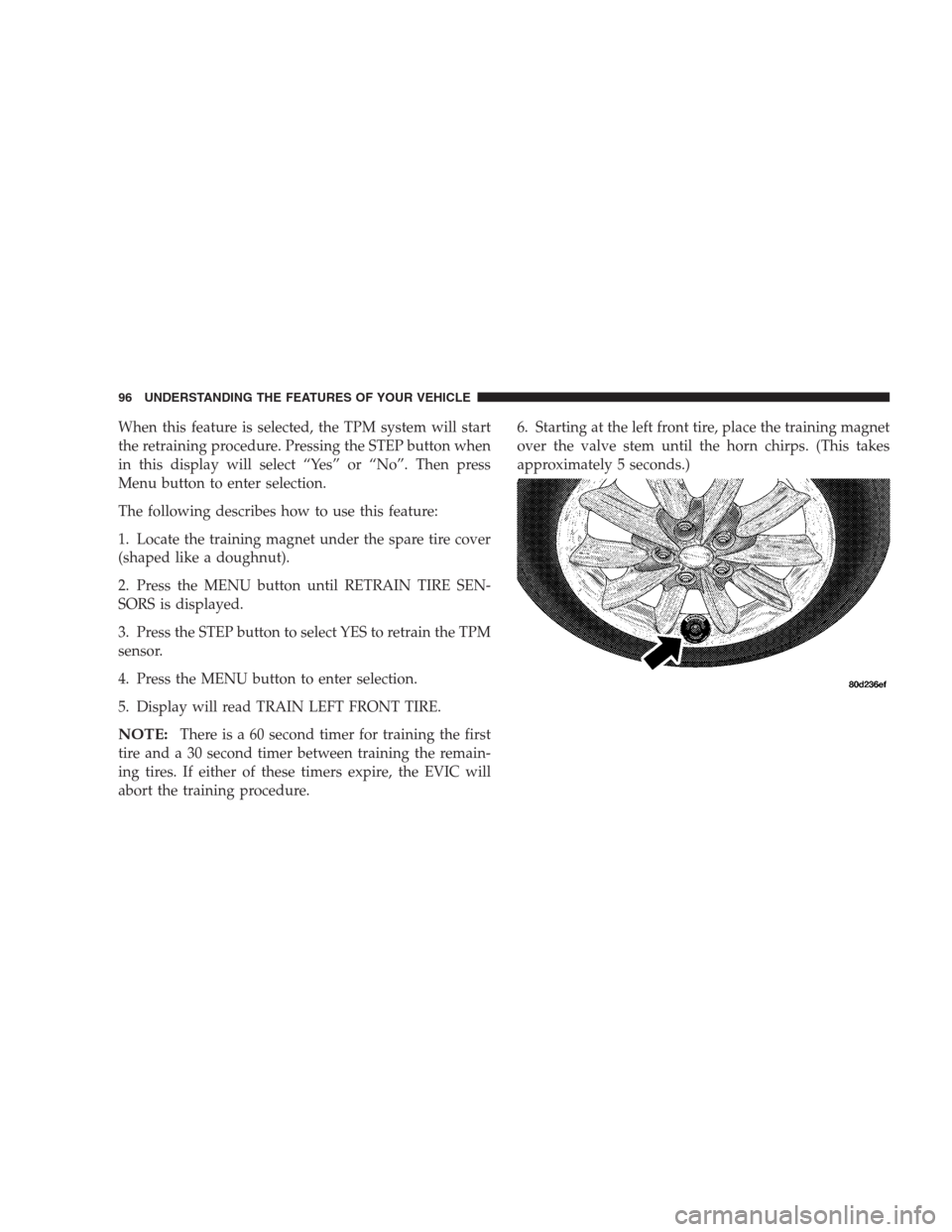
When this feature is selected, the TPM system will start
the retraining procedure. Pressing the STEP button when
in this display will select “Yes” or “No”. Then press
Menu button to enter selection.
The following describes how to use this feature:
1. Locate the training magnet under the spare tire cover
(shaped like a doughnut).
2. Press the MENU button until RETRAIN TIRE SEN-
SORS is displayed.
3. Press the STEP button to select YES to retrain the TPM
sensor.
4. Press the MENU button to enter selection.
5. Display will read TRAIN LEFT FRONT TIRE.
NOTE:There is a 60 second timer for training the first
tire and a 30 second timer between training the remain-
ing tires. If either of these timers expire, the EVIC will
abort the training procedure.6. Starting at the left front tire, place the training magnet
over the valve stem until the horn chirps. (This takes
approximately 5 seconds.)
96 UNDERSTANDING THE FEATURES OF YOUR VEHICLE
Page 97 of 277
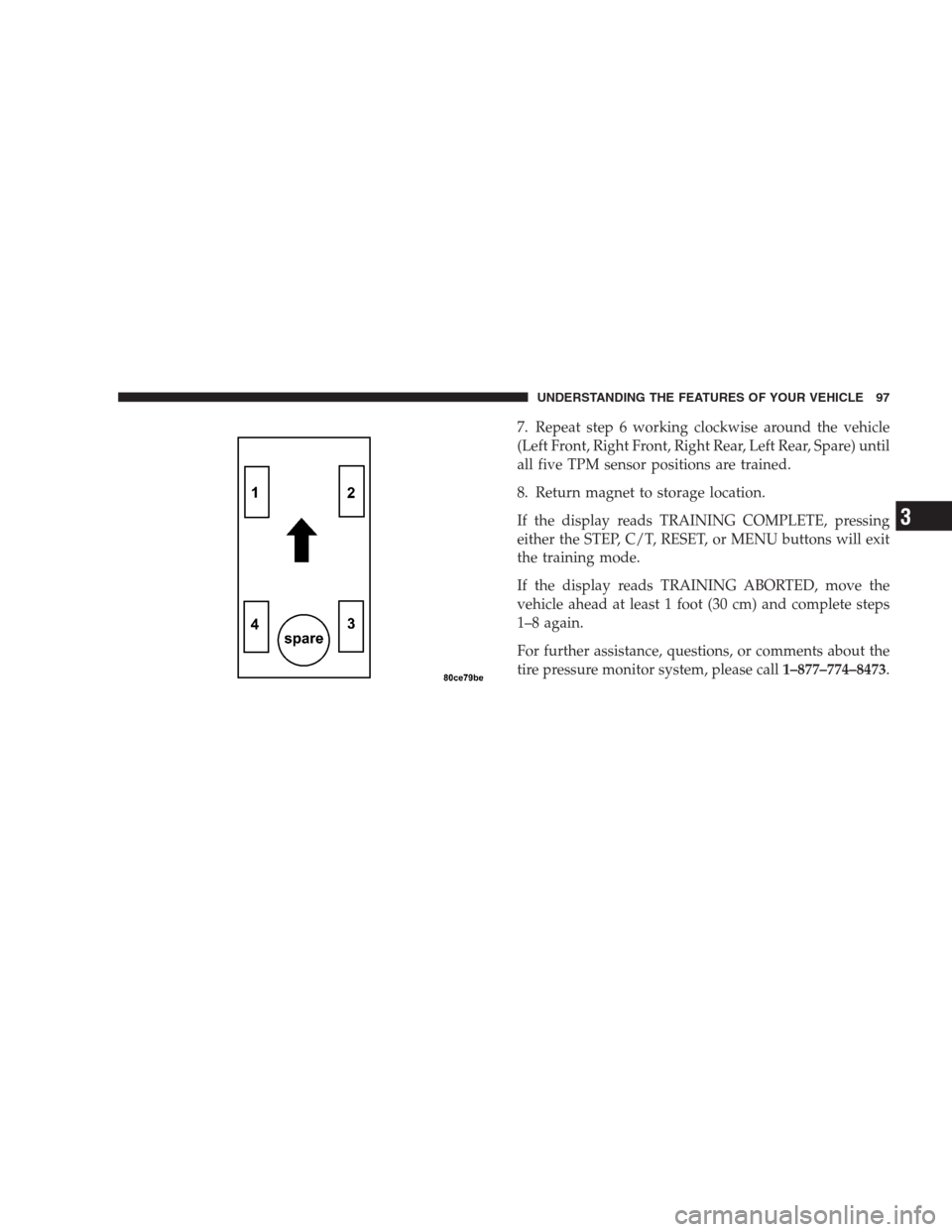
7. Repeat step 6 working clockwise around the vehicle
(Left Front, Right Front, Right Rear, Left Rear, Spare) until
all five TPM sensor positions are trained.
8. Return magnet to storage location.
If the display reads TRAINING COMPLETE, pressing
either the STEP, C/T, RESET, or MENU buttons will exit
the training mode.
If the display reads TRAINING ABORTED, move the
vehicle ahead at least 1 foot (30 cm) and complete steps
1–8 again.
For further assistance, questions, or comments about the
tire pressure monitor system, please call1–877–774–8473.
UNDERSTANDING THE FEATURES OF YOUR VEHICLE 97
3
Page 146 of 277
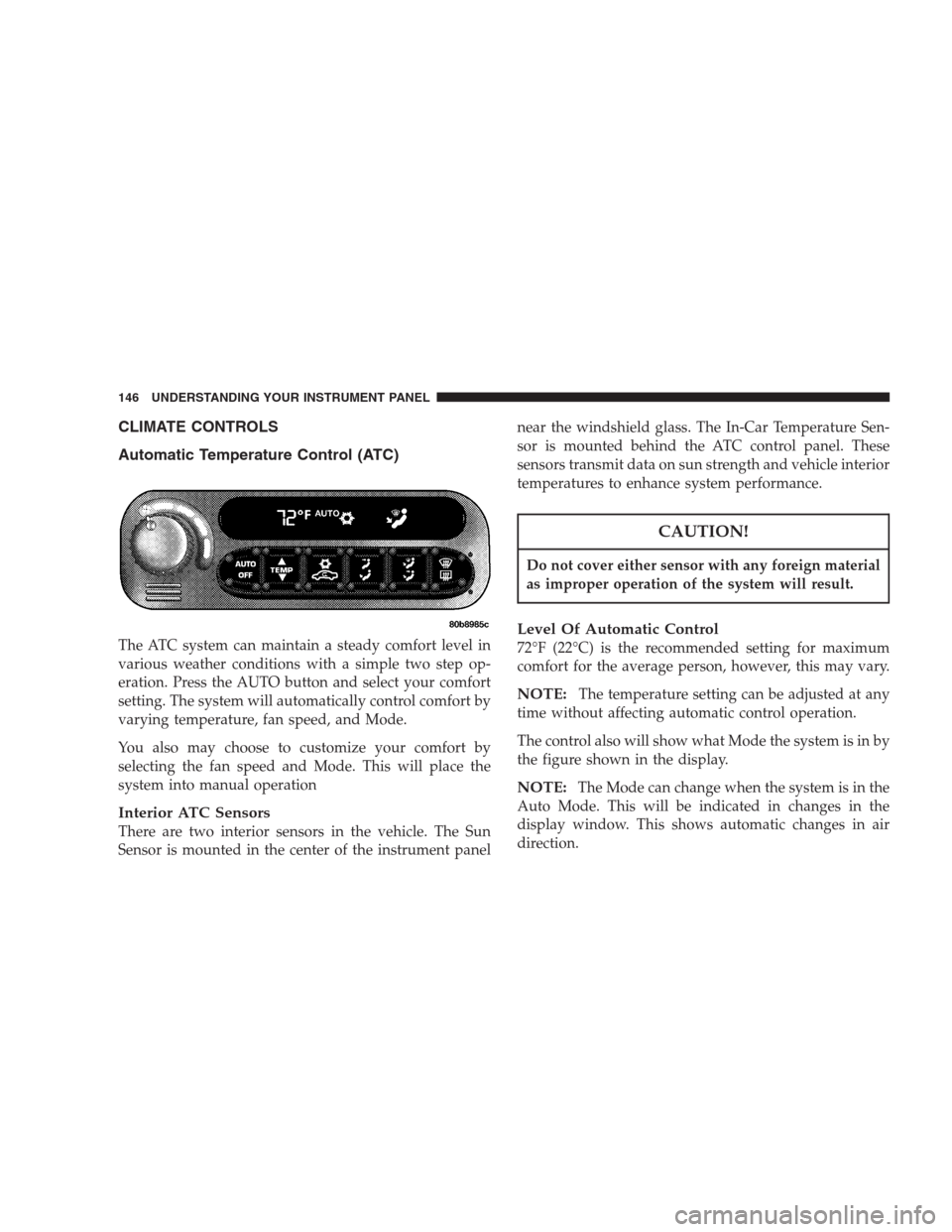
CLIMATE CONTROLS
Automatic Temperature Control (ATC)
The ATC system can maintain a steady comfort level in
various weather conditions with a simple two step op-
eration. Press the AUTO button and select your comfort
setting. The system will automatically control comfort by
varying temperature, fan speed, and Mode.
You also may choose to customize your comfort by
selecting the fan speed and Mode. This will place the
system into manual operation
Interior ATC Sensors
There are two interior sensors in the vehicle. The Sun
Sensor is mounted in the center of the instrument panelnear the windshield glass. The In-Car Temperature Sen-
sor is mounted behind the ATC control panel. These
sensors transmit data on sun strength and vehicle interior
temperatures to enhance system performance.
CAUTION!
Do not cover either sensor with any foreign material
as improper operation of the system will result.
Level Of Automatic Control
72°F (22°C) is the recommended setting for maximum
comfort for the average person, however, this may vary.
NOTE:The temperature setting can be adjusted at any
time without affecting automatic control operation.
The control also will show what Mode the system is in by
the figure shown in the display.
NOTE:The Mode can change when the system is in the
Auto Mode. This will be indicated in changes in the
display window. This shows automatic changes in air
direction.
146 UNDERSTANDING YOUR INSTRUMENT PANEL
Page 166 of 277
![CHRYSLER 300 M 2004 1.G Owners Manual period. The cold inflation pressure must not exceed the
maximum values molded into the tire side wall.
Tire pressure may increase from 2 to 6 psi [.13 to.41 bars]
(13 to 40 kPa) during operation. Do N CHRYSLER 300 M 2004 1.G Owners Manual period. The cold inflation pressure must not exceed the
maximum values molded into the tire side wall.
Tire pressure may increase from 2 to 6 psi [.13 to.41 bars]
(13 to 40 kPa) during operation. Do N](/img/25/8462/w960_8462-165.png)
period. The cold inflation pressure must not exceed the
maximum values molded into the tire side wall.
Tire pressure may increase from 2 to 6 psi [.13 to.41 bars]
(13 to 40 kPa) during operation. Do NOT reduce this
normal pressure build up or your tire pressure will be too
low.
The tire pressures shown on the tire label apply only to
the tire sizes listed on the label.
Tire Pressure Monitor System — If Equipped
The Tire Pressure Monitor System (TPM) monitors the
pressure in all 4 road tires and the full size spare. The
TPM system uses wireless technology to monitor tire
pressure levels. Sensors, mounted to each wheel as part
of the valve stem, transmit tire pressure readings to a
receiver located in the overhead console. The tire pres-
sure status is shown in the Electronic Vehicle Information
Center (EVIC) display. Pressure in the spare tire, al-
though monitored, is not displayed in the EVIC. Refer to
“Understanding the Features of Your Vehicle, Electronic
Vehicle Information Center (EVIC)” for more informa-
tion. The TPM system functions even when the EVIC is
not set on the tire pressure display screen.The TPM system informs you of a low or high tire
pressure condition. If this occurs, correct your tire infla-
tion pressure as soon as possible, and inspect all of your
tires. Be sure to use a high quality gauge when adjusting
pressure. The TPM system is designed to periodically
monitor your tire pressure but cannot be expected to
function as a tire pressure gauge. There can be a delay
between the instant you adjust the air pressure in a tire
and when the system updates the display. The TPM
system is not intended to provide you with notification of
rapid air loss.
The following chart indicates the TPM system pressure
levels. A threshold is the level at which the TPM system
provides you with an indication.
300M 300M Special
High Pressure
Threshold45 psi (310 kPa) 45 psi (310 kPa)
Placard Pressure 30 psi (207 kPa) 32 psi (220 kPa)
Low Pressure
Threshold24 psi (165 kPa) 26 psi (179 kPa)
NOTE:A TPM system does not replace normal tire
maintenance.
166 STARTING AND OPERATING
Page 167 of 277
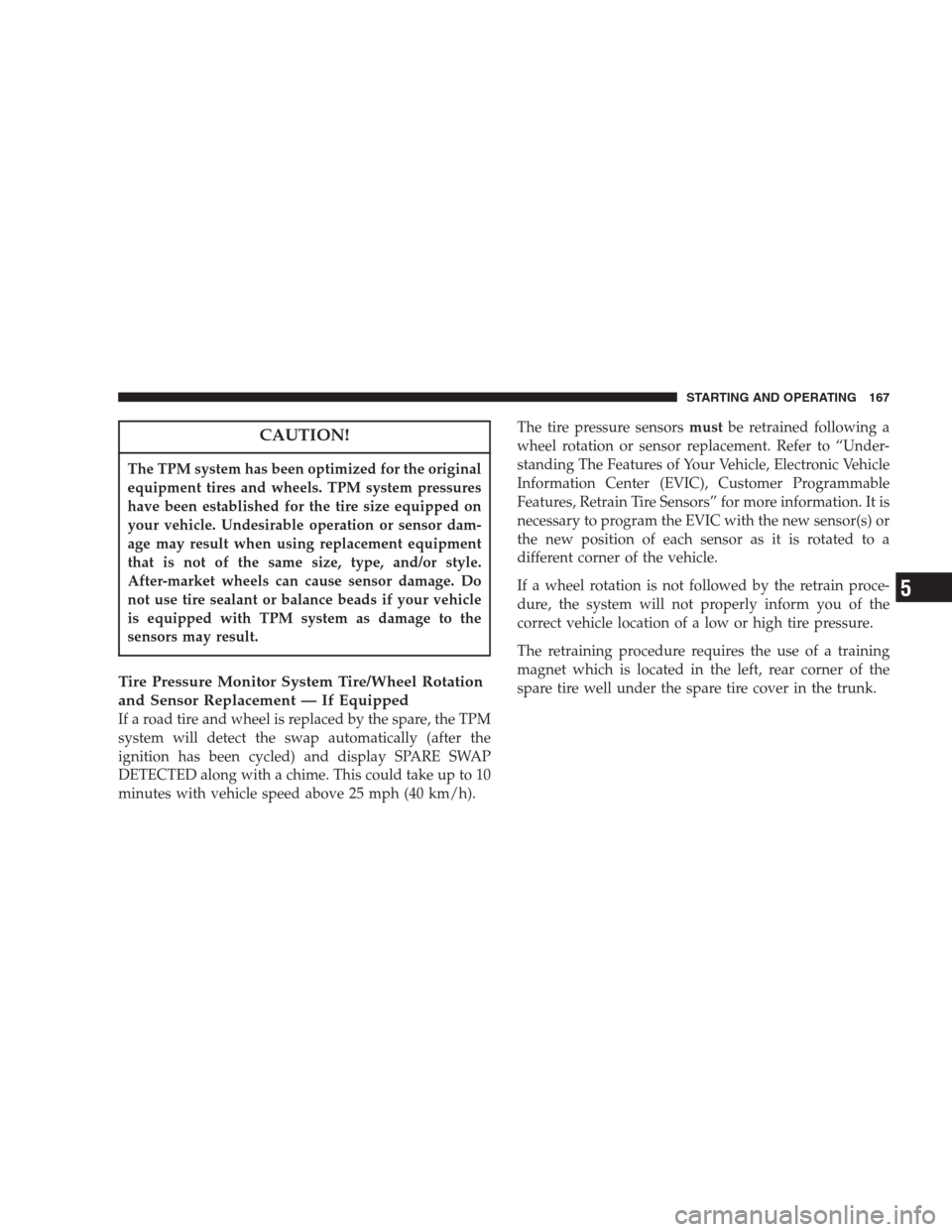
CAUTION!
The TPM system has been optimized for the original
equipment tires and wheels. TPM system pressures
have been established for the tire size equipped on
your vehicle. Undesirable operation or sensor dam-
age may result when using replacement equipment
that is not of the same size, type, and/or style.
After-market wheels can cause sensor damage. Do
not use tire sealant or balance beads if your vehicle
is equipped with TPM system as damage to the
sensors may result.
Tire Pressure Monitor System Tire/Wheel Rotation
and Sensor Replacement — If Equipped
If a road tire and wheel is replaced by the spare, the TPM
system will detect the swap automatically (after the
ignition has been cycled) and display SPARE SWAP
DETECTED along with a chime. This could take up to 10
minutes with vehicle speed above 25 mph (40 km/h).The tire pressure sensorsmustbe retrained following a
wheel rotation or sensor replacement. Refer to “Under-
standing The Features of Your Vehicle, Electronic Vehicle
Information Center (EVIC), Customer Programmable
Features, Retrain Tire Sensors” for more information. It is
necessary to program the EVIC with the new sensor(s) or
the new position of each sensor as it is rotated to a
different corner of the vehicle.
If a wheel rotation is not followed by the retrain proce-
dure, the system will not properly inform you of the
correct vehicle location of a low or high tire pressure.
The retraining procedure requires the use of a training
magnet which is located in the left, rear corner of the
spare tire well under the spare tire cover in the trunk.
STARTING AND OPERATING 167
5